DISCLAIMER: The vast majority of this information is either directly quoted from the sources below or only slightly changed. Very little of it is my original thoughts, save a paragraph here or there. I attribute the following completely to my sources and make no claims otherwise. If so desired I will remove this content from the website without hesitation if asked to do so by TIMEGHOST or by any of the original copyright holders. My intent is purely the sharing of historical knowledge regarding Canada and the Battle of the Atlantic.
Sources:
“The Far Distant Ships” by Joseph Schull, ISBN-10 0773721606 (An official operational account published in 1950, somewhat sensationalist)
“North Atlantic Run” by Marc Milner, ISBN-10 0802025447 (Written in an attempt to give a more strategic view of Canada’s contribution than Joseph Schull’s work, published 1985)
“Reader’s Digest: The Canadians at War: Volumes 1 & 2” ISBN-10 0888501617 (A compilation of articles ranging from personal stories to overviews of Canadian involvement in a particular campaign. Contains excerpts from a number of more obscure Canadian books written after the war, published 1969)
“The Corvette Navy” by James B. Lamb, ISBN 0-7737-3225-X, (A shorter book that contains personal anecdotes of Mr Lamb’s service aboard corvettes during the Battle of the Atlantic, and later his involvement in the D-day landings)
Pictures are courtesy of Wikimedia Commons, Library and Archives Canada, Uboat.net, The Rooms Provincial Photo Archive, and other sources. I only use photos that exist in the Public Domain unless otherwise stated.
New Acronyms, Drums in the Deep, Finally Time to Practice
It was inevitable that many of the escorts needed to protect shipping along the American coast would have to come from the mid-ocean. Yet so long as the convoys adhered to diversive routing into very high latitudes, the extended passages and heavy storm damage to escorts prevented the transfer of some of their numbers to the now-embattled southern routes. Actually, Admiral King had long considered the circuitous routing of North Atlantic convoys to be a waste of resources. In November of 1941 he recommended to Admiral H.R. Stark, chief of Naval Operations in Washington, that the convoy route be pulled straight and the extra escorts produced thereby used to kill U-boats. King was frustrated with the emphasis on evasion and wanted the whole basis of the system changed. He was not alone in his desire to establish a ‘tramline’ in the North Atlantic. Just a week after Pearl Harbour the British proposed changes that would have tied the slow convoys to the great-circle route and have NEF escorts call at Londonderry as their eastern terminus. Further, the British also wanted all escort operations for slow convoys placed under C-in-C, WA, once again, including the Canadians. Naturally, King supported the idea of using the great-circle route, but he informed Stark (on December 25th,1941) that the command arrangements were to remain unaltered.
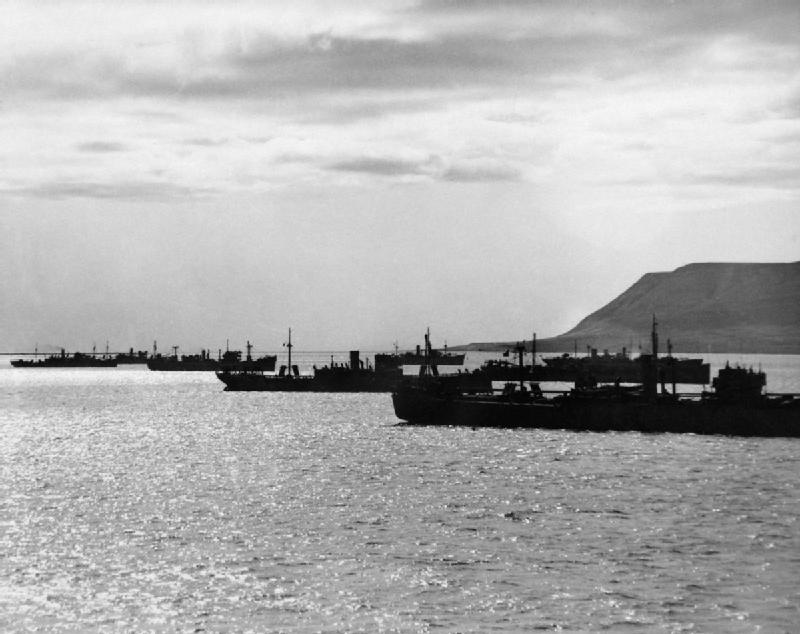
(British and American merchant vessels taking refuge in Hvalfjordhur, date unknown)
King followed his comments on the British proposals with a plan of his own. Foul winter weather, he observed was making escort operations ‘untenable.’ In addition, the bases from which the USN was operating (Argentia and Hvalfjordhur) King considered to be too exposed. It is also plain that the commander of the Atlantic fleet was displeased with the damaging effect that operations from the two advanced bases were having on USN efficiency. For this reason the eastern terminus for USN escorts was switched to Londonderry at the end of January, something Murray had attempted but failed to do for NEF in November.
In early February King finally made an official proposal to the Admiralty to alter convoy and escort arrangements along the lines already discussed. By sailing all convoys along the great-circle route it would be possible to reduce the strain on escort forces and in fact to eliminate one whole force (the RN’s UK-Iceland section). And if the limits of local Canadian escorts were pushed a little farther eastwards, it would be possible for escorts to take convoys all the way from Newfoundland to Ireland. Under the new arrangement NEF, as an ocean escort force, ceased to exist (its title pass to local Newfoundland forces). From the second week in February all escorts operating between Newfoundland and Ireland became part of the Mid-Ocean Escort Force (MOEF). Escort groups also received new designations. The old NEF numbering system (and that of the British groups committed to MOEF) was changed to a letter-number combination in Commonwealth usage.
For example, C 1 for the first Canadian escort group. The US Navy designated all groups operating in its zone by Task Unit numbers as part of Task Force Four, so C 1 in an American zone would be called TU 4.1.11. Aside from the fairer weather of more southern latitudes, the appeal of Northern Ireland was strong. The Americans were already at work on a large naval base at Londonderry, and the same port held excellent RN escort facilities. Maintenance and training services were up to date and ideally suited to the types of problems faced by the RCN. In the Western Atlantic, British (or B) groups began to call at Newfoundland. They did not, however, make St John’s their port of call except in an emergency. Rather, RN escort groups were granted access to the American base at Argentia, where things were much less congested. Ironically the Canadians had only just recently started using the facilities themselves after an invitation by the US. Eventually, growing British use of the base would force the RCN out, although this was compensated for by new RCN access to facilities in Ireland.
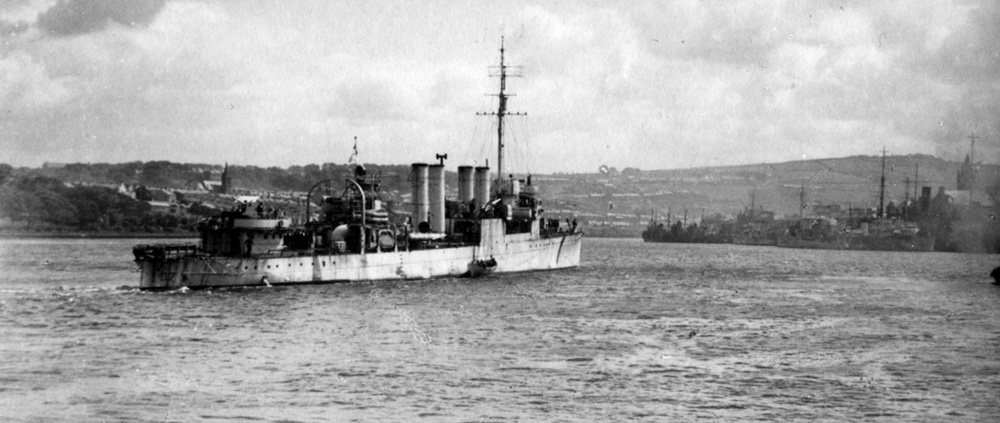
(HMS Beverley on the Foyle River, Londonderry, 1941, I could not confirm whether or not this photo is in the Public Domain)
At the time that Admiral King obtained British agreement for the restructuring of the escort and convoy system, he also informed the Admiralty of his intention to sail the American groups of MOEF directly to Boston at the end of each convoy cycle in order to provide the ships with much-needed maintenance and repairs. How King justified the time that would be lost in light of the clear need for efficient use of escort time is uncertain. It does illustrate, however, that the Americans were quite prepared to balance operational demands and those of the fleet. NEF, of course was in much the same condition. So many Canadian warships lay at St John’s suffering from defects in December that Admiral Bristol, commander of Task Force Four at Argentia, considered that Canadian strength was all on paper, and that the RCN’s effort was on the verge of collapse. It is not known if Murray ever considered seeking permission for his ships to call in at Halifax between passages in order to obtain access to better facilities. Since the Naval Staff would not permit the establishment of a training group, it is unlikely that it would have sanctioned trips to Nova Scotia. Indeed, given Murray’s estimation of the manning staff at Halifax, it is inconceivable that he would have encouraged any use of the RCN’s most important base unless in case of emergency or regularly scheduled maintenance. In February the effects of visiting Halifax were every bit as bad as they had been the previous fall. Chambly went to refit during February and came back into operation 72 hours after recommissioning with 80% of her crew new drafts.
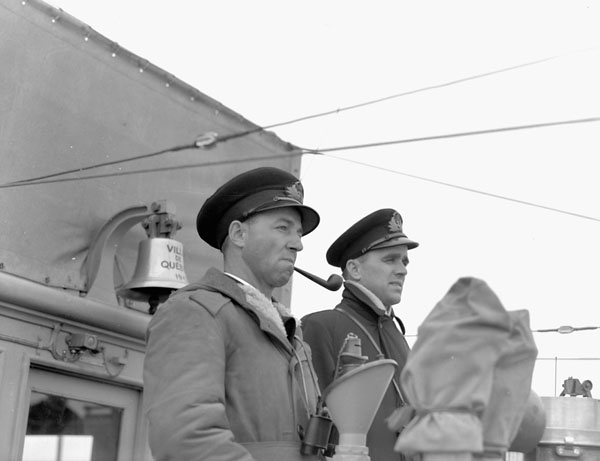
(Two officers on the bridge of HMCS Ville de Quebec, circa 1942).
Whether Murray harboured any resentment against Rear Admiral Jones in Halifax (or vice versa) as a result of the disputed manning policy is unclear. Jones was Murray’s contemporary; indeed both were members of the Royal Naval College of Canada class of 1912. Their careers were virtually identical, and they had stayed even in promotions. By 1941 Murray and Jones were at the top of the list to succeed the first generation of senior RCN officers. Those who knew both men would recall that their personalities were quite different. Jones was ambitious and, unlike Murray, an indifferent ship handler. That limitation earned him the nickname ‘Jetty Jones’ after his ship, Ottawa, struck the Halifax to Dartmouth ferry in a fog and she was forced to remain alongside at the dockyard when the rest of Canada’s destroyers sailed off to Europe in June 1940. Jones was nonetheless well liked by those who served under him. William Sclater, a member of intelligence staff at Halifax in 1942, later published a glowing eulogy to Jones, describing him as the father of the wartime navy.
Those who served in Newfoundland in 1941-42 would disagree, if for no other reason than that Halifax and Newfoundland commands were at cross-purposes during those crucial years. This alone might have set Jones and Murray at loggerheads, but their bitter rivalry was of long standing and was well known in the pre-war navy. When Jones was due to give up command of Assiniboine in September 1940 to become commanding officer, Atlantic Coast, Murray was scheduled to replace him. But since it was unthinkable that one command should pass from one to the other, Commander C.R.H. Taylor had to take over the destroyer for a few weeks. Officially, Murray and Jones got along well enough, but their relationship could not be described as friendly. Certainly, Murray always resented Jone’s promotion to rear admiral on the 1st of December.1941, one day ahead of himself. In the end, both reached career pinnacles suited to their respective temperaments. Jones eventually became Chief of the Naval Staff, but was publicly overshadowed by Murray, the navy’s foremost and well known flag officer.
For most of the first year of its operations, NEF and its successor, the Canadian component of MOEF, were caught between the bitter North Atlantic and a hungry, growing service at home. Even if Murray did not actively discourage the sending of ships to Halifax to effect repairs, maintenance suffered from another, more insidious conspiracy within the escorts themselves. Under continuous pressure from operations through the latter part of 1941 and on throughout the winter, chiefs, petty officers, and even officers manipulated defects lists in order to ensure time for rest for their men. Neglected maintenance was complicated during 1942 by ever-greater operational demands and more missed refits. The cumulative effect would haunt the RCN until 1944.
The ambiguity which affected RCN escort operations in the North Atlantic during the fall of 1941 clearly had an impact on the orderly development of the expansion fleet. Certainly NEF and its notable characters found much to learn from the lessons of SC-42 and other convoy battles. But for the navy as a whole, escort operations in late 1941 were not the learning experience which a similar exposure to enemy action had been to the RN the previous winter. The Naval Staff was too preoccupied with the everyday affairs of expansion, with the development of bases and the simple commissioning of ships. It was too intent upon building a large service quickly to concern itself overly with the plight of reservists serving in the ‘stepping stones’ of the fleet-development program. Indeed, had the Americans fulfilled their promise, NEF would have evolved into a purely local force and Canada’s naval war effort would have been directed overseas. By January 1942 the war, which the Naval Staff never conceded to have infested NEF’s area of operations, leapt past the escort forces based at St John’s and fell, in full fury, on the American east coast.
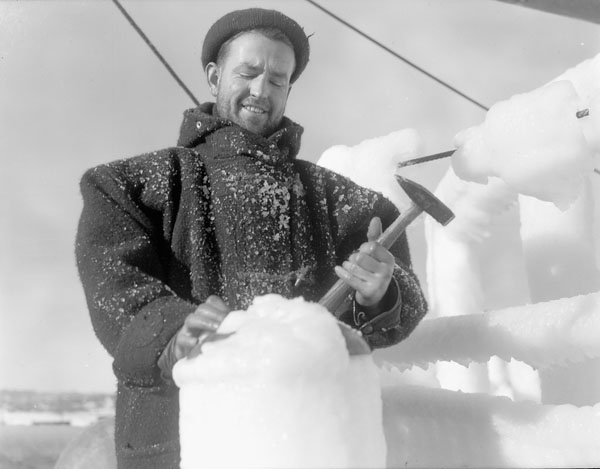
(Seaman Gunner R. E. Walsh chopping ice from the superstructure of the corvette HMCS Lunenburg)
While the departures of American forces in large numbers eventually placed more responsibility on RCN mid-ocean escorts, the new danger area lay off the Nova Scotia and New England coasts. It was natural for the RCN to shift its priorities accordingly, and the establishment of the Western Local Escort Force (WLEF), the new link between western convoy ports and MOEF, became the primary objective in 1942. With this development the fleet was pushed even harder, and the opportunities needed to make good the defects, both material and professional, revealed in the battles of 1941 were lost.
American entry into the war gave promise of eventual Allied victory. But until her mighty resources could be mobilized and put into the field, US participation as a combatant opened vast new areas for Axis attack and placed enormous strain on available forces. The burden of carrying America through her mobilization was not unforeseen. The RCN realized that the broadening of the war would seriously stretch Canadian resources. It was also evident to the Canadians, junior partners that they were, that there was precious little the navy could do about this.
“Relieving the RN and the USN of duties and the loan of ships,” Plans Division warned Nelles in late January 1942, "depends on circumstances outside the control of the RCN."The determining factor was the Allied nations’ naval position relative to that of the Axis. Any deterioration in that situation was likely to ‘be reflected in increased demands on the RCN by their Allies.’
Even before the Germans launched their offensive along the US east coast, the RCN felt the weight of the expanding war. By January the Ottawa Trade and Intelligence Centre was straining in its efforts to fill the gap in control of merchant shipping caused by America’s precipitous entry into the war. The USN’s naval-control-of-shipping organization was still new, and Ottawa formed a vital communication link between it and the extensive Commonwealth system. In addition, for the first six months of 1942 Ottawa ran the tracking and routing duties for the area west of 40 degrees and north of the equator. These were heavy responsibilities, ones for which the NSHQ was not prepared. Nonetheless, they were handled efficiently until the USN was ready to take over its rightful duties in the early summer.
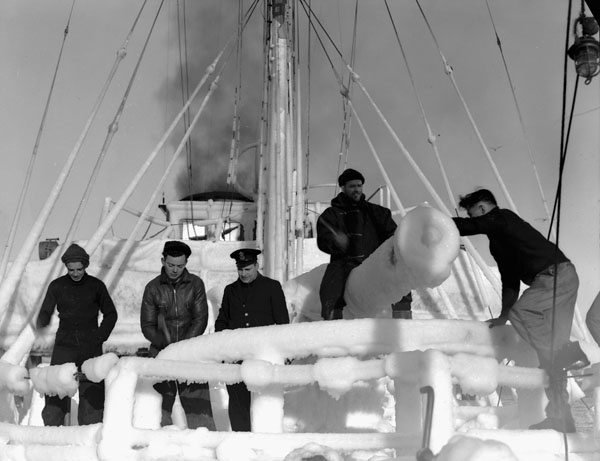
(Ratings clearing ice from the forecastle of HMCS Lunenburg, Halifax, January 1942)
Further direct aid to the Americans and the British in the form of escorts was expected as NSHQ resigned itself to generous support of the Allied naval effort. But increased demands on the fleet did not absolve the navy from responsibility for its maintenance and readiness for action. Certainly, despite the spread of the war in early 1942, neither the RN nor the USN was willing to compromise fully on quality. Admiral King had already insisted in February, even as the Allies scrambled for more escorts, that American MOEF groups layover in Boston at the end of every cycle. By May, when the scramble was even more intense, an American officer sent to report on the British ASW training noted with surprise that the RN found ‘time for this instruction somehow.’ The contrast with Canadian priorities in 1942 could not have been sharper.
Yet, in the context of the pandemonium of mounting losses and the advent of new theatres of war, NSHQ’s acceptance of new responsibilities and the resulting reduction, in both absolute and relative terms, of the RCN’s commitment to MOEF are comprehensible. Through the winter of 1941-42 the development of local Canadian forces gradually overtook the practice of sending every available escort to St John’s. The shift in effort was given a push by the establishment of the Halifax-based Western Local Escort Force in February, which gave a new form and importance to a hitherto nebulous force of almost non-combatant escorts. The RCN also received substantial assistance in the establishment and operation of WLEF from the RN, which sent twelve aged but very well-equipped short ranged destroyers to serve with Halifax based groups.
Even more significant to the development of the RCN were the many highly skilled and experienced North Atlantic veterans who commanded the RN escorts of WLEF. Several of these men were to linger on in key RCN staff posts until the end of the war. Although chronically under strength until 1944, Halifax-based escort groups became responsible for one-third of the main ocean trade routes. Fortunately they were spared sustained enemy pressure and were always under the lee of the coast of North America. But in 1942 WLEF was every bit as important to the RCN as its commitment to MOEF. Though for a number of reasons WLEF was never as prestigious as its mid-Atlantic counterpart, its expansion and development dominated RCN activities in this crucial stage of the war.
Initially, MOEF strength was not affected by the build-up of forces closer to home, since newly commissioned ships were simply redirected to Jone’s command at Halifax. By February the RCN’s corvette commitment to MOEF was still at its January peak of fifty. RCN destroyer strength, however, was down from eleven to eight. The decline was not the result of need in WLEF but stemmed from the now greater operational responsibilities of MOEF over those of NEF. The Town-class destroyer escorts St Clair, Columbia, and Niagara simply lacked sufficient endurance to operate between Newfoundland and Ireland and were therefore relegated to WLEF. The loss of three RCN destroyers was thus an indirect result of the shift of escort strength southwards, but the effect on C groups was no less real. Canadian MOEF destroyer operations were now restricted to the six pre-war River class, and two long-range Towns (not all of the four stackers were the same class of ship). The balance of destroyer complements in Canadian groups was made up of whatever destroyers the RN chose to assign, invariably aged Town-class ships. Their value in comparison to RCN vessels was on a ship by ship basis. Some had benefited from better RN access to equipment and training, some had not.
The weakening of the RCN’s destroyer commitment to MOEF and the navy’s inability to redress the situation from Canadian resources held serious consequences for the war in the mid-ocean and the success of Canadian operations there. March 1942 brought the first sizeable reduction in Murray’s command when five operational corvettes (Arrowhead, Kenogami, Matapedia, Nanaimo, and Snowberry) were assigned directly to WLEF. One other corvette, Spikenard, was lost to enemy action, though her place in the ranks was filled briefly by Sudbury. In some measure the impact of this first major shift was offset by the fairer weather of early spring and the lower latitudes now prevalent in convoy routing.
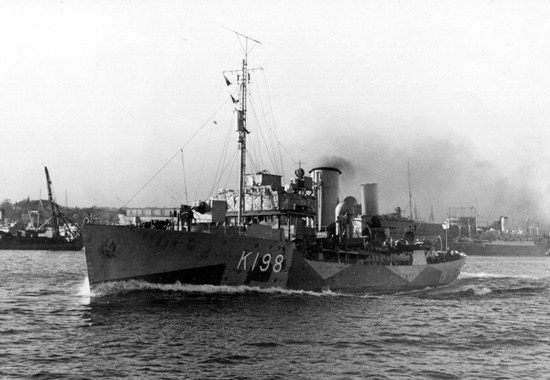
(HMCS Spikenard, torpedoed on the 11th of February, 1942. Hit by U-136 whilst escorting SC-67. There were only eight survivors). Photo courtesy of the Department of National Defence
But much of whatever slack existed was needed to fill the growing gaps in American MOEF groups. By March the five A (American) groups contained only a token force of USN destroyers or Coast Guard cutters. The balance of group strength was now made up of RCN (A 1-3) or RN (A 4-5) corvettes. Thus the mixed groups which both the RCN and USN feared in late 1941 had come to be. The progressive withdrawal of American escorts from MOEF did little to stem the rising tide of losses along the U.S. coast because the USN steadfastly refused to adopt convoys. To the British and Canadians this failure was both perplexing and exasperating. The Commonwealth navies had shared two years of hard-won experience with the USN, and yet the Americans seemed to have missed the fundamental defensive importance of convoys. It was particularly frustrating to see ships escorted safely to proximity to Halifax and then lost in large numbers that, by virtue of their proximity to land, should have been safe.
The Americans argued that shortage of escorts kept them from instituting a system of coastal convoy. In truth, the USN had enough escorts to begin convoys, but not enough of the type they liked, destroyers. The establishment of a convoy system also required a considerable act of will, and it may have been American exposure to NEF in late 1941 that set them against inadequately escorted convoys.
“It should always be born in mind.” the USN’s Board on the Organization of East Coast Convoys reported in March 1942, “that effective convoying depends upon the escort being in sufficient strength to permit their taking offensive action against the attacking submarines… Any protection less than this simply results in the convoy’s becoming a convenient target.”
In many ways this was not entirely incorrect, but it was only true in situations where the escorts were facing down large scale packs on the open ocean. The American coastline was well within range of air cover and inshore waters had a limiting effect on U-boat operations. More importantly, the object of the convoy system was, by this point, the protection of shipping, not the destruction of the enemy. Even then, convoying aided the latter as well. With the ocean otherwise clear of ships the U-boats were forced to attack the convoys, where the defenders could focus their strength. The U-boats targeting of merchant shipping was the only constant upon which you could build a defense. It had been a difficult pill to swallow for professional naval men in the RN and RCN. The USN naval men seemed unable or unwilling to learn from their allies mistakes.
Ships were being sunk off the coast in alarming numbers. Unguarded and alone, they sank off New York and Boston, off Virginia and Maine, off Miami and Havana. A shockingly large number were sunk in the Gulf of Mexico, some just a few dozen miles off New Orleans. Canadian coastal cities and towns (St Johns too) had long been under nighttime blackout to prevent silhouetting ships as they sailed along the coast. The full power of nighttime city lights could reach miles out to sea; perfectly silhouetting ships as they sailed nearby. The effect was even worse off the US coast. They had much larger population centres, and a lot more light to throw out across the sea. U-boat commanders just had to sit offshore facing inland, and wait for a ship to sail between them and the lights. It was easy pickings. While air cover was plentiful, US airmen had a tendency to assume that things had gone in their favor when a kill could not be confirmed, and the number of U-boats reported sunk by the US is higher than actual losses suffered by the Kriegsmarine. Operationally, this had a more negative effect than one might imagine. A reported sinking of a U-boat that had conducted several successful attacks might divert resources away from an area that was now considered safe, while the U-boat could simply wait some time, then return to hunting when things cooled off. The slaughter of Drumbeat would continue on through winter, spring, and summer of 1942.

(The tanker Pennsylvania Sun, torpedoed by U-571 in July, 1942).
Meanwhile, whilst the USN sought ways of inflicting defeats on the U-boats without resorting to convoys, Admiral King, in his capacity as commander of the Western Atlantic, instructed the RCN to establish a convoy system between Boston and Halifax (the BX and XB convoys). The shuttle began in March and became a WLEF responsibility. As the U-boats pushed further south and the Americans losses mounted in the Pacific, more USN escorts were withdrawn from MOEF. The result was a transfer of Groups A4 and A5 to RN control, and the renumbering of the Groups to B6 and B7 respectively. The Americans also withdrew completely from two other groups, A1 and A2, which had RCN corvette complements. Because no Canadian destroyers were available as replacements, A1 and A2 were simple disbanded, leaving Murray with eight additional escorts. The resulting sizeable reduction in MOEF’s strength forced a major rearrangement of convoy cycles in late April.
But for the moment, the combination of spring weather, better routing, and elimination of American groups gave Murray much-needed leverage within his command. The shorter route and fairer weather had already brought relief to the C groups by the end of March, at least enough to allow another reconsideration of the establishment of a training group at St John’s. The initiative to get operational training under way off Newfoundland came from the new Captain (D) E.R. Mainguy, RCN. Mainguy was an affable character, well respected by officers and men alike for his professional skill and fairness. He had joined the navy in 1918 and followed a typical RCN career pattern, alternating between Canadian and RN postings. In October 1939 he had taken command of Assiniboine, his first command, upon her transfer to the RCN. After nearly two years of escort duty off Canada and in the Western Approaches (largely aboard Ottawa, which he took over in April 1940) Mainguy was appointed Captain (D), Halifax, in June 1941, moving to the same post at St Johns in early 1942. Although by 1942 he was an experienced North Atlantic veteran and viewed as an innovator during his later tenure as chief of the naval staff, Mainguy is best remembered for his intense interest in the welfare of sailors. His tendency to be people oriented contrasts sharply with the more businesslike manner of his RN counterparts, and certainly during 1942 Mainguy was not on the same wavelength as staff officers at Western Approaches.
On the last day of March 1942 Mainguy passed a memo to Murray proposing that Chambly and Prentice be withdrawn from operational duties to form the nucleus of an operational-training establishment. Mainguy suggested the formation of one additional group in order that units could be trained in rotation. It was, in fact, the very scheme shelved at the end of 1941. Murray wasted no time informing NSHQ of his intention of going ahead with the plan ‘as soon as operationally possible’. He also emphasized, lest the Naval Staff seek to nip his plans in the bud, that the scheme was quite different from the type of individual escort instruction provided by HMCS Sambro in Halifax. Murray might also have added that group training was precisely what the navy’s operational escorts now badly needed.
Naval HQ offered no objection this time, and Prentice began operations on the 6th of April. On that day Chambly went to sea in company with Buctouche, Cobalt, and Rosthern. Shortly after they cleared the approaches to St John’s the corvettes were joined by the destroyer St Francis, (RCN Four stacker) and the ships divided into two divisions to conduct maneuvering exercises. No sooner were the latter underway than Prentice received an urgent signal ordering him to investigate a U-boat sighting close to the West of Cape Race. Prentice rearranged his group in line of bearing swept the area, but to no avail. The group passed a quiet night at sea and was joined the next morning by the corvette Dunvegan,(a WLEF ship). Throughout the 7th of April the six ships conducted towing, screening, depth-charge, and gunnery exercises. In the afternoon the AA crews of the corvettes were given practice on air bursts put up by St Francis. By 19:30 local time on the second day of the program all of the escorts were secure alongside at St John’s, their brief foray as a training group completed.

(The gun-shield art of HMCS Buctouche. Almost every corvette had a piece of custom art such as this on the gun-shield, usually related to their namesake.)